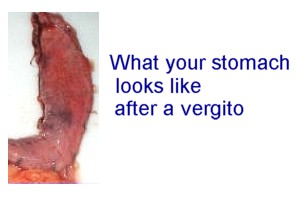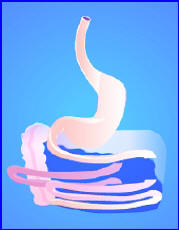|
the Vergito |
|
Summary of points in article
The vergito is a new procedure by Dr Hustad which is advertised to offer normal digestion and no bypassing of any small bowel while changing the metabolism to help you lose weight.
Then a section of small bowel (looks like a third of it so that's about 6 feet) is taken from towards the end of the small bowel and it's put nearer to the stomach tube. Here is what that looks like in the pictures on the website:
And finally Dr Oz's favorite thing to blame for obesity, the Omentum, a sort of sheath around the bowels, is removed. According to providers, this surgery without bypassing anything, works on your metabolism helping you to lose weight. The reduction of the stomach, reduces the "ghrelin making" cells thus reducing your appetite. The switching around of the small bowel, makes the food pass through the end of the small bowel before it goes through the beginning so that cuts down on absorption of nutrients. And the removal of the omentum - well let's let Dr Hustad tell about this:
Gee, like all new surgeries, this sounds safe and effective - how could it not be, we ask? Well, first, in truth, the whole surgery is built on theory. They have never observed what ghrelin does except in a couple of rat studies with rats which were heavily modified genetically so they don't produce ghrelin and they stopped feeding. But that ghrelin even AFFECTS appetite has NOT been observed in human beings and even though you may think of some humans (like some attorneys), as rats, truth is, we are very different from rats which eat instinctively only when they are hungry. As we all know, most of us can very easily and enjoyably eat when we are NOT hungry and if we only ate when we were hungry, well, most of us would not have such a weight problem in the first place! So reducing our appetite, if in fact, this is what ghrelin does and there so far, IS NO PROOF OF THIS, might not solve the problem of overeating at all. And the stomach is generally 40 oz in size so if we reduce its size to 2 oz, that's removing 95 percent of the stomach and throwing it in the garbage. Logic would tell us that a 95 percent smaller stomach would NOT give us normal digestion because in removing all the ghrelin making cells, we are also removing the cells which make all the enzymes to digest fats and proteins... ouch. This is NOT normal digestion. And worse yet, if something goes wrong like we get an ulcer or something, we could end up losing our ENTIRE stomach, something which has happened to a few folks who had the duodenal switch (which calls for removing LESS stomach than this surgery calls for). So right away, here's a REALLY big down side - once you throw most of your stomach into the garbage, there is NO chance of reversal or going back if something goes wrong. The switching around of the small bowel is supposed to slow down absorption with the idea that there are less means of absorbing nutrients in the lower part of the small bowel - but we also know that the small bowel tends to re-configure itself when we mess with it so this is another theory which may work or not work and you are the guinea pig - also this switching surgery while not an out and out bypass, is still involving a lot of cuts in your small bowel, each which could form a leak (anytime - not just after surgery) and adhesions or scar tissue which could cause bowel obstruction and other not nice places - you don't want to go there type thing. And finally the removal of the omentum. This is an organ which Dr Mehmet Oz has made famous. He feels it's something which causes obesity so naturally following that line of thought, it makes sense to remove it, right? WRONG. Look up "Omentum" on the web and I mean other than what Dr Oz says (and I love him, don't get me wrong but even someone you love can be off beat when we are talking theory). Fact remains we DO NOT KNOW what the Omentum does. But chances are if it's included in our digestive system, it's probably something we need and something which we will eventually miss if it's removed. Remember in the 1950's? Well, most of you checking out surgery don't remember that far back but I do. Anytime you had a bunch of sore throats, the tonsils (in the back of your throat) were blamed and kids had tonsillectomies like it was going in to have teeth filled - no big deal we were told. I had a tonsillectomy and it hurt A LOT - it was a big deal. But much worse yet, about 20 years later, it was discovered that the tonsils are the biggest lymph node in the body, and if you remove them, the person might become somewhat immune challenged which certainly DID happen to me. And worse yet, I know 7 people INCLUDING myself who started to really put on weight big time (despite being very active) after our tonsillectomies so damage to the pituitary or something else might have occurred. Looking back in retrospect, just because we don't know what it does, doesn't mean we should play fast and loose with removing it. The theory here - obesity, says Dr Hustad, is caused by inflammation and so if you remove the Omentum, that reduces the inflammation. But the definition of the Omentum disagrees with Dr Hustad's definition. According to IT, the Omentum has been thought TO REDUCE inflammation in that area of the body.
Will you no longer store fat because this organ is removed? Don't count on it. If you eat too much, you will still store fat. In regards to the claim that the Omentum has anything to do with insulin resistance (which is the factor which can cause diabetes), first again there is no proof of this and second, insulin resistance means that your muscle cells are slow to take up insulin (which carries glucose to your muscles) so what does THAT have to do with the Omentum? Will you not want to eat because you have a stomach the size of a thumb? Again, don't count on it. When you smell pizza or other, you will want to eat because MOST eating we do is not because we are hungry (that is even if ghrelin does have something to do with appetite). Remember how leptin affected appetite in rats and was thought to be the latest and greatest thing for humans except it didn't work that way in humans? One thing we KNOW ghrelin DOES do, is - less ghrelin means less growth hormone and less growth hormone means you look and feel older, quicker. So if you really get less ghrelin forever, that would not be necessarily something for healthy aging. Bottom line - I'd really hold back on this one - it's has some rather scary side effects and might not even help you keep the weight off. Here are the listed side effects:
Notice the last line of this - EXPERIMENTAL! But you pay for it because insurance, of course, doesn't cover it. And then they talk about revisions - in case you don't get the weight loss - you can - have more surgery. hmmmm. Caveat Emptor... let the buyer beware. There is NO EASY WAY OUT. Don't look for one. |

 First, the 40 oz stomach is reduced to
a
2-3 oz tube. In the picture to the left it doesn't look like they are
removing 95 percent of the stomach but do the math... 2/40 = .05 or leaving 5
percent of the
First, the 40 oz stomach is reduced to
a
2-3 oz tube. In the picture to the left it doesn't look like they are
removing 95 percent of the stomach but do the math... 2/40 = .05 or leaving 5
percent of the stomach. If you want to see what your stomach will REALLY look like
after this surgery, take a look at the picture to the right which is a real
photo. In the photo to the right, they removed about 90 percent of the
stomach so it's actually a larger stomach tube than you will end up with after
having a "vergito" surgery. A lot smaller than the nice little cartoon, isn't
it! In truth, your stomach will look more like a thumb...
stomach. If you want to see what your stomach will REALLY look like
after this surgery, take a look at the picture to the right which is a real
photo. In the photo to the right, they removed about 90 percent of the
stomach so it's actually a larger stomach tube than you will end up with after
having a "vergito" surgery. A lot smaller than the nice little cartoon, isn't
it! In truth, your stomach will look more like a thumb...